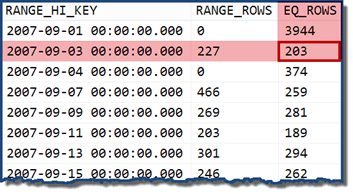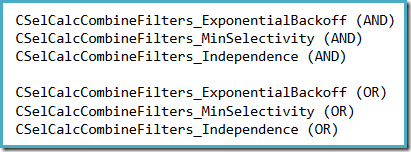Single Predicates
Estimating the number of rows qualified by a single query predicate is often straightforward. When a predicate makes a simple comparison between a column and a scalar value, the chances are good that the cardinality estimator will be able to derive a good quality estimate from the statistics histogram. For example, the following AdventureWorks query produces an exactly correct estimate of 203 rows (assuming no changes have been made to the data since the statistics were built):
SELECT COUNT_BIG(*)
FROM Production.TransactionHistory AS TH
WHERE TH.TransactionDate = '20070903';

Looking at the statistics histogram for the TransactionDate column, it is clear to see where this estimate came from:
DBCC SHOW_STATISTICS (
'Production.TransactionHistory',
'TransactionDate')
WITH HISTOGRAM;

If we change the query to specify a date that falls within a histogram bucket, the cardinality estimator assumes the values are evenly distributed. Using a date of 2007-09-02 produces an estimate of 227 rows (from the RANGE_ROWS entry). As an interesting side-note, the estimate remains at 227 rows regardless of any time portion we might add to the date value (the TransactionDate column is a datetime data type).
If we try the query again with a date of 2007-09-05 or 2007-09-06 (both of which fall between the 2007-09-04 and 2007-09-07 histogram steps), the cardinality estimator assumes the 466 RANGE_ROWS are evenly split between the two values, estimating 233 rows in both cases.
There are many other details to cardinality estimation for simple predicates, but the foregoing will do as a refresher for our present purposes.
The Problems of Multiple Predicates
When a query contains more than one column predicate, cardinality estimation becomes more difficult. Consider the following query with two simple predicates (each of which is easy to estimate alone):
SELECT
COUNT_BIG(*)
FROM Production.TransactionHistory AS TH
WHERE
TH.TransactionID BETWEEN 100000 AND 168412
AND TH.TransactionDate BETWEEN '20070901' AND '20080313';
The specific ranges of values in the query are deliberately chosen so that both predicates identify exactly the same rows. We could easily modify the query values to result in any amount of overlap, including no overlap at all. Imagine now that you are the cardinality estimator: how would you derive a cardinality estimate for this query?
The problem is harder than it might at first sound. By default, SQL Server automatically creates single-column statistics on both predicate columns. We can also create multi-column statistics manually. Does this give us enough information to produce a good estimate for these specific values? What about the more general case where there might be any degree of overlap?
Using the two single-column statistic objects, we can easily derive an estimate for each predicate using the histogram method described in the previous section. For the specific values in the query above, the histograms show that the TransactionID range is expected to match 68412.4 rows, and the TransactionDate range is expected to match 68,413 rows. (If the histograms were perfect, these two numbers would be exactly the same.)
What the histograms cannot tell us is how many from these two sets of rows will be the same rows. All we can say based on the histogram information is that our estimate should be somewhere between zero (for no overlap at all) and 68412.4 rows (complete overlap).
Creating multi-column statistics provides no assistance for this query (or for range queries in general). Multi-column statistics still only create a histogram over the first named column, essentially duplicating the histogram associated with one of the automatically-created statistics. The additional density information provided by the multi-column statistic can be useful to provide average-case information for queries that contain multiple equality predicates, but they are of no help to us here.
To produce an estimate with a high degree of confidence, we would need SQL Server to provide better information about the data distribution – something like a multi-dimensional statistics histogram. As far as I know, no commercial database engine currently offers a facility like this, though several technical papers have been published on the subject (including a Microsoft Research one that used an internal development of SQL Server 2000).
Without knowing anything about data correlations and overlaps for particular value ranges, it is not clear how we should proceed to produce a good estimate for our query. So, what does SQL Server do here?
SQL Server 7 – 2012
The cardinality estimator in these versions of SQL Server generally assumes that values of different attributes in a table are distributed completely independently of each other. This independency assumption is rarely an accurate refection of the real data, but it does have the advantage of making for simpler calculations.
AND Selectivity
Using the independency assumption, two predicates connected by AND (known as a conjunction) with selectivities S1 and S2, result in a combined selectivity of:
(S1 * S2)
In case the term is unfamiliar to you, selectivity is a number between 0 and 1, representing the fraction of rows in the table that pass the predicate. For example, if a predicate selects 12 rows from a table of 100 rows, the selectivity is (12/100) = 0.12.
In our example, the TransactionHistory table contains 113,443 rows in total. The predicate on TransactionID is estimated (from the histogram) to qualify 68,412.4 rows, so the selectivity is (68,412.4 / 113,443) or roughly 0.603055. The predicate on TransactionDate is similarly estimated to have a selectivity of (68,413 / 113,443) = roughly 0.603061.
Multiplying the two selectivities (using the formula above) gives a combined selectivity estimate of 0.363679. Multiplying this selectivity by the cardinality of the table (113,443) gives the final estimate of 41,256.8 rows:

OR Selectivity
Two predicates connected by OR (a disjunction) with selectivities S1 and S2, results in a combined selectivity of:
(S1 + S2) – (S1 * S2)
The intuition behind the formula is to add the two selectivities, then subtract the estimate for their conjunction (using the previous formula). Clearly we could have two predicates, each of selectivity 0.8, but simply adding them together would produce an impossible combined selectivity of 1.6. Despite the independency assumption, we must recognize that the two predicates may have an overlap, so to avoid double-counting, the estimated selectivity of the conjunction is subtracted.
We can easily modify our running example to use OR:
SELECT COUNT_BIG(*)
FROM Production.TransactionHistory AS TH
WHERE
TH.TransactionID BETWEEN 100000 AND 168412
OR TH.TransactionDate BETWEEN '20070901' AND '20080313';
Substituting the predicate selectivities into the OR formula gives a combined selectivity of:
(0.603055 + 0.603061) - (0.603055 * 0.603061) = 0.842437
Multiplied by the number of rows in the table, this selectivity gives us the final cardinality estimate of 95,568.6:

Neither estimate (41,257 for the AND query; 95,569 for the OR query) is particularly good because both are based on a modelling assumption that does not match the data distribution very well. Both queries actually return 68,413 rows (because the predicates identify exactly the same rows).
Trace Flag 4137 – Minimum Selectivity
For SQL Server 2008 (R1) to 2012 inclusive, Microsoft released a fix that changes the way selectivity is computed for the AND case (conjunctive predicates) only. The Knowledge Base article in that link does not contain many details, but it turns out the fix changes the selectivity formula used. Instead of multiplying the individual selectivities, cardinality estimation for conjunctive predicates now uses the lowest selectivity alone.
To activate the changed behaviour, supported trace flag 4137 is required. A separate Knowledge Base article documents that this trace flag is also supported for per-query use via the QUERYTRACEON hint:
SELECT COUNT_BIG(*)
FROM Production.TransactionHistory AS TH
WHERE
TH.TransactionID BETWEEN 100000 AND 168412
AND TH.TransactionDate BETWEEN '20070901' AND '20080313'
OPTION (QUERYTRACEON 4137);
With this flag active, cardinality estimation uses the minimum selectivity of the two predicates, resulting in an estimate of 68,412.4 rows:

This happens to be just about perfect for our query because our test predicates are exactly correlated (and the estimates derived from the base histograms are also very good).
It is reasonably rare for predicates to be perfectly correlated like this with real data, but the trace flag may nevertheless help in some cases. Note that the minimum selectivity behaviour will apply to all conjunctive (AND) predicates in the query; there is no way to specify the behaviour at a more granular level.
There is no corresponding trace flag to estimate disjunctive (OR) predicates using minimum selectivity.
SQL Server 2014
Selectivity computation in SQL Server 2014 behaves the same as previous versions (and trace flag 4137 works as before) if the database compatibility level is set lower than 120, or if trace flag 9481 is active. Setting the database compatibility level is the official way to use the pre-2014 cardinality estimator in SQL Server 2014. Trace flag 9481 is effective to do the same thing as at the time of writing, and also works with QUERYTRACEON, though it is not documented to do so. There is no way to know what the RTM behaviour of this flag will be.
If the new cardinality estimator is active, SQL Server 2014 uses a different default formula for combining conjunctive and disjunctive predicates. Although undocumented, the selectivity formula for conjunctions has been discovered and documented several times now. The first one I remember seeing is in this Portuguese blog post and the follow-up part two issued a couple of weeks later. To summarize, the 2014 approach to conjunctive predicates is to use exponential backoff: given a table with cardinality C, and predicate selectivities S1, S2, S3 … Sn, where S1 is the most selective and Sn the least:
Estimate = C * S1 * SQRT(S2) * SQRT(SQRT(S3)) * SQRT(SQRT(SQRT(S4))) …
The estimate is computed the most selective predicate multiplied by the table cardinality, multiplied by the square root of the next most selective predicate, and so on with each new selectivity gaining an additional square root.
Recalling that selectivity is a number between 0 and 1, it is clear that applying a square root moves the number closer to 1. The effect is to take account of all predicates in the final estimate, but to reduce the impact of the less selective predicates exponentially. There is arguably more logic to this idea than under the independency assumption, but it is still a fixed formula – it does not change based on the actual degree of data correlation.
The 2014 cardinality estimator uses an exponential backoff formula for both conjunctive and disjunctive predicates, though the formula used in the disjunctive (OR) case has not yet been documented (officially or otherwise).
SQL Server 2014 Selectivity Trace Flags
Trace flag 4137 (to use minimum selectivity) does not work in SQL Server 2014, if the new cardinality estimator is used when compiling a query. Instead, there is a new trace flag 9471. When this flag is active, minimum selectivity is used to estimate multiple conjunctive and disjunctive predicates. This is a change from the 4137 behaviour, which only affected conjunctive predicates.
Similarly, trace flag 9472 can be specified to assume independence for multiple predicates, as previous versions did. This flag is different from 9481 (to use the pre-2014 cardinality estimator) because under 9472 the new cardinality estimator will still be used, only the selectivity formula for multiple predicates is affected.
Neither 9471 nor 9472 is documented at the time of writing (though they may be at RTM).
A convenient way to see which selectivity assumption is being used in SQL Server 2014 (with the new cardinality estimator active) is to examine the selectivity computation debug output produced when trace flags 2363 and 3604 are active. The section to look for relates to the selectivity calculator that combines filters, where you will see one of the following, depending on which assumption is being used:
There is no realistic prospect that 2363 will be documented or supported.
Final Thoughts
There is nothing magic about exponential backoff, minimum selectivity, or independence. Each approach represents a (hugely) simplifying assumption that may or may not produce an acceptable estimates for any particular query or data distribution.
In some respects, exponential backoff represents a compromise between the two extremes of independence and minimum selectivity. Even so, it is important not to have unreasonable expectations of it. Until a more accurate way is found to estimate selectivity for multiple predicates (with reasonable performance characteristics) it remains important to be aware of the model limitations and watch out for (potential) estimation errors accordingly.
The various trace flags provide some control over which assumption is used, but the situation is far from perfect. For one thing, the finest granularity at which a flag may be applied is a single query – estimation behaviour cannot be specified at the predicate level. If you have a query where some predicates are correlated and others independent, the trace flags may not help you much without refactoring the query in one way or another. Equally, a problematic query may have predicate correlations that are not modelled well by any of the available options.
Ad-hoc use of the trace flags requires the same permissions as DBCC TRACEON – namely sysadmin. That is probably fine for personal testing, but for production use a plan guide using the QUERYTRACEON hint is a better option. With a plan guide, no additional permissions are required to execute the query (though elevated permissions are required to create the plan guide, of course).









Hi,
This was interesting, thanks for the article. I wanted to ask whether there is any resource that explains the likely culprits/root causes when cardinality estimates are "over-estimates", are "spot-on", and are "under-estimates". This article seems to suggest that in a query with multiple predicates, under estimation could be included among the root causes for under-estimation. I don't know that such a article or blog post exists but it would seem a good topic. Unfortunately, I don't have the breadth of knowledge to undertake this, so I'm hoping somebody already has!
Thanks for any insight you may provide!
May I know how 68412.4 is calculated for transactionid statistics.
Simply add up the relevant entries in the histogram.
Paul,
Is it possible for you to copy or mail me the output of below query as it seems I am bit off track with figures mentioned by you. Thanks in advance..
DBCC SHOW_STATISTICS (
'Production.TransactionHistory',
'TransactionID')
WITH HISTOGRAM;
No need to send me the stats info. I got it now after reading https://sqlkiwi.blogspot.com/2014/04/cardinality-estimation-for-disjunctive-predicates-in-2014.html
I was mistakenly taking whole column density (0.000008815) into consideration rather than the predicate one (0.603061).
Thanks very much!!
Ok, cool :)
Very useful and comprehensive article, thanks! At least in certain limited cases where you have a relatively small number of distinct values for one of the correlated columns, it seems that filtered statistics may be a decent (albeit imperfect) way to approach this problem.
For example, here is how the problem has manifested itself in our environment:
The database had a large fact table that has data something like (attributeId, locationId, attributeValue), with a primary key of (attributeId, locationId) partitioned over a persisted computed column attributeIdMod1000 (defined as "attributeId % 1000"). Obviuosly the attributeId and attributeIdMod1000 columns are heavily correlated :)
The partitioning is place because the core use case is to use data for one attribute at a time, (though different ad hoc queries may all use different attributes). While it's true that there are some shortcomings to the round-robin partition approach, it would be difficult to change now and has served us reasonably well.
However, I have recently come across a couple situations where the underestimated cardinality (using both attributeId and attributeIdMod1000 as predicates) causes SQL Server to believe the rows coming from this large fact table will fewer than those coming from the dimension table being joined. As you can imagine, we get some major disk spills when "oops, that 94K row hash table I thought I was building turns out to be 100 million rows".
In this case, creating statistics "ON (attributeMod1000) WHERE attributeId = X" for each attribute addresses the cardinality issues quite well. Because the data for each attribute is typically write-once read-only, this works pretty well as long as we are thoughtful of not exceeding the maximum number of statistics objects (2000) for a given table.
Thanks again for the article!
Thanks for the kind comments and for taking the time to share your experiences.
Paul,
This is an excellent article! Any chance you could write one on JOIN density/cardinality estimation at some point in the future? Would like to understand that in more detail because I've been noticing in many instances the optimizer grossly mis-estimated the number of output rows and it makes me wonder why (a different formula is used?).
Hi Nick,
Thanks. Yes, maybe. It's something I have thought about doing on-and-off for years. The problem is the details quickly get overwhelming (and probably a bit tedious) for many potential readers. We'll see. Would you be particularly interested in pre-2014 or new CE behaviours? A schematic (or even better, AdventureWorks) example of the sort of join you find being mis-estimated might help too. No promises at this stage, but thanks for the feedback.
If I'm not too late in replying about this last point regarding JOIN estimations, I have derived an example in AdventureWorks2012 that is not too dissimilar to a Production problem (or at least curiosity) that I have.
Our Production system is on SQL Server 2012 SP3, as is my own local AdventureWorks2012 db.
select dtl.*
from sales.SalesOrderHeader hdr join sales.SalesOrderDetail dtl on dtl.SalesOrderID = hdr.SalesOrderID
where CustomerID = 11091
The actual number of rows returned is 59. The estimation is 321.627. I must admit, I always assumed that All Density was used for a join. That happens to be 3.178134E-05 on SalesOrderID, and would return 108 by my calculation.
Paul, I'd be very grateful if you could find the time to explain where the 321.627 comes from.
Many thanks
James
Hi James,
You can find some information about this (for both CE models) in https://msdn.microsoft.com/en-us/library/dn673537.aspx
Essentially the histograms for the join column are matched up. There are some variations in the detail, and whether the filter on CustomerID is assessed first.
Paul
Hi Paul, thanks very much for this. I've always wanted to know about join estimation, so this has made my Friday. They say it's the little things in life …. :)
I shall be sharing this document, together with your above post, with our Developers to pass on how even the best statistics we can achieve (up-to-date, and FULLSCAN) can be "watered down" with each join and filter, and that, therefore, the more joins and filters in a query, the further away the cardinality estimations deviate from the truth.
Thanks again,
James